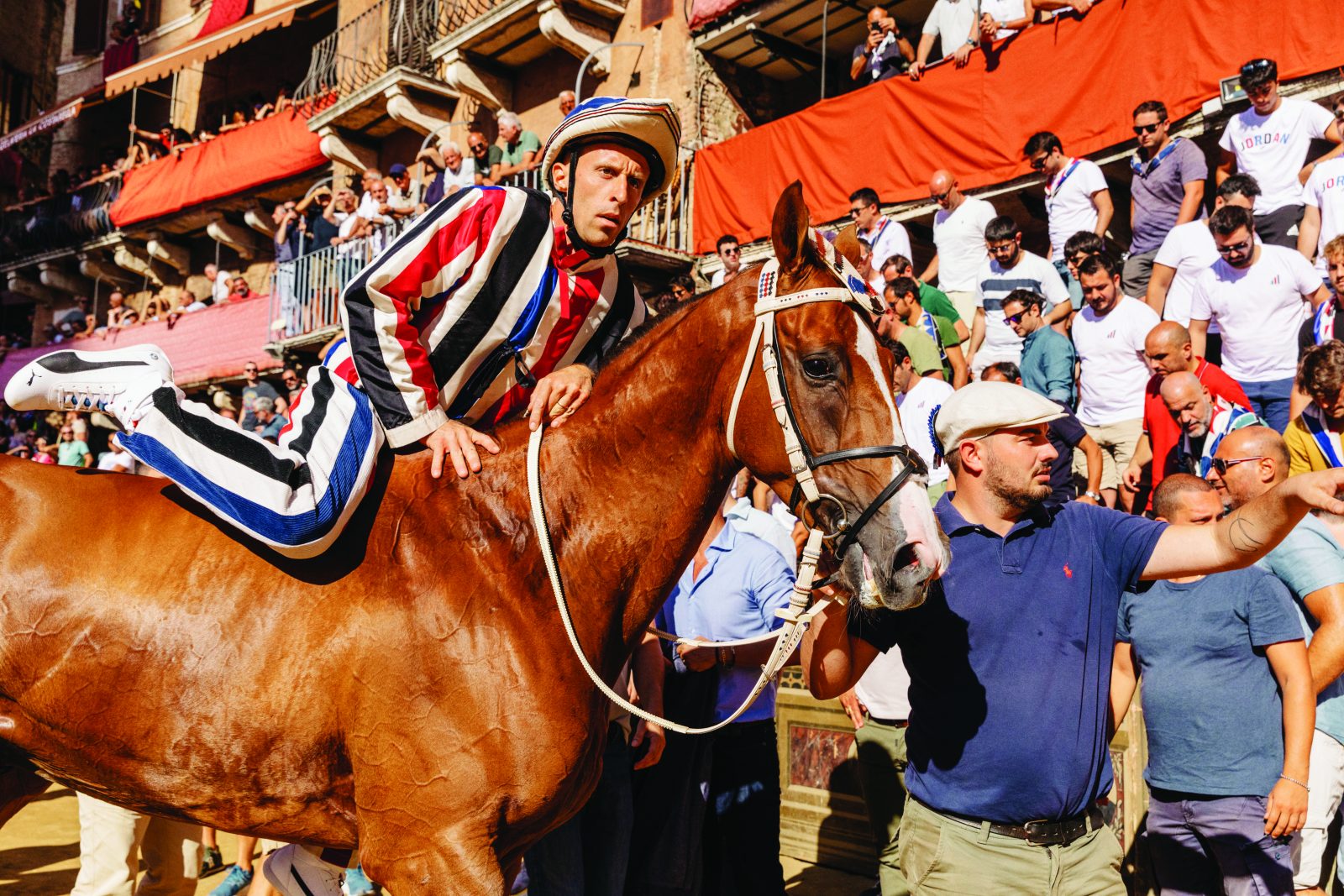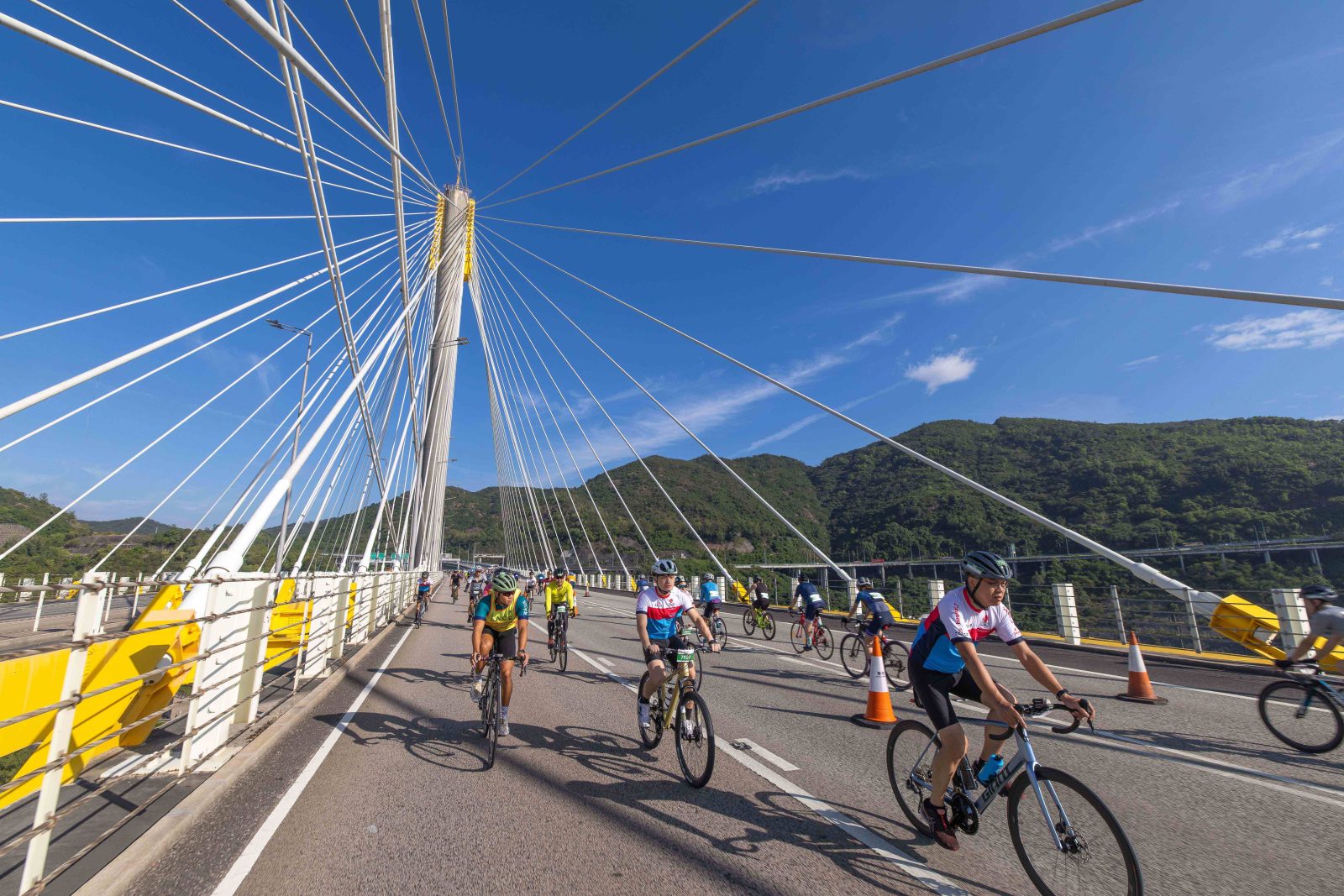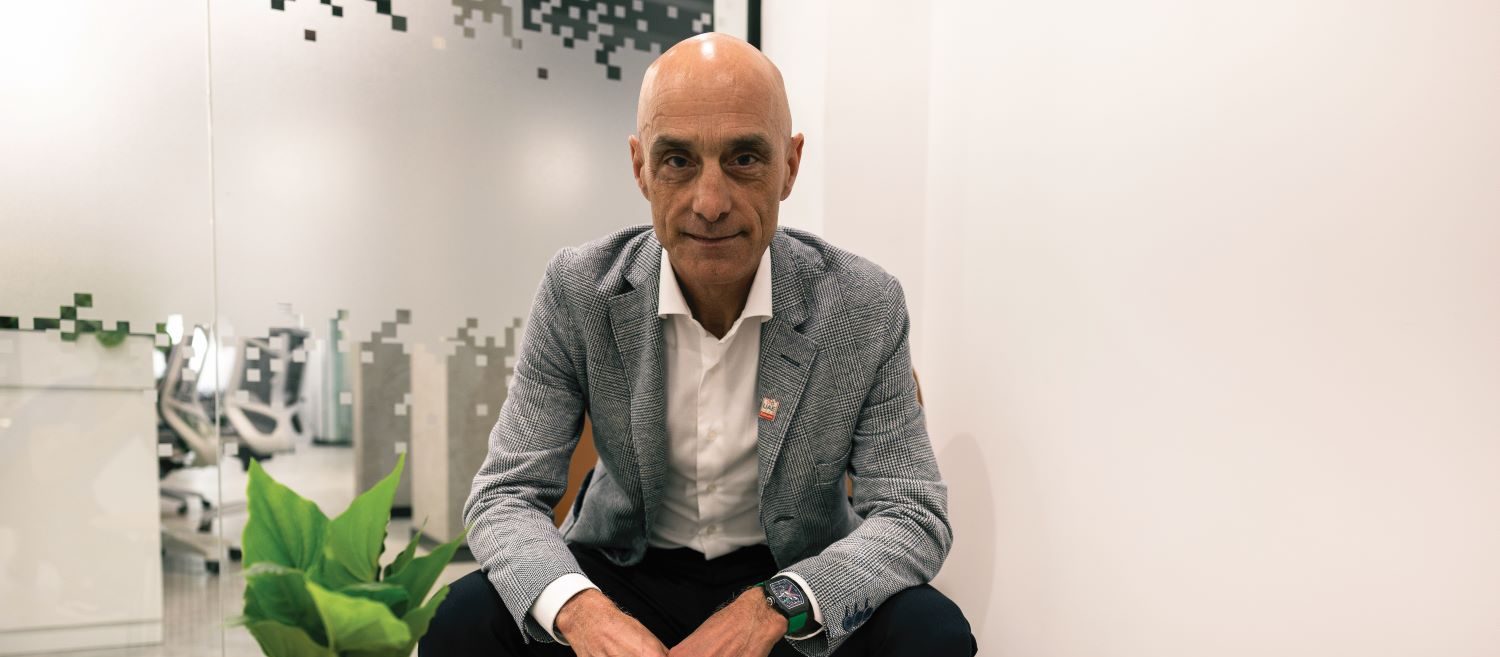For cycling fans, Strade Bianche marks the first great Classic of the year. But the city of Siena hosts an even more famous and chaotic event – the Palio horse race. Cyclist visits both to compare.

Words Andy McGrath Photography David Powell
‘Fear? There’s always fear,’ says Diego Ulissi. ‘Fear is part of the DNA of every bike racer. The important thing is managing it.’
The fear is heightened at Strade Bianche on its treacherous gravel sectors. Fear of the unknown: crashes, punctures and mechanical problems. If you’re a Tuscan, there’s also the fear of performing poorly in front of your family, friends and fan club.
An instant Classic since its first running in 2007, this March one-day race is unmistakably Tuscan, from its eponymous white gravel roads to the cypress trees and finale in medieval Siena’s shell-shaped central square, the Piazza del Campo. But it means even more than stunning scenery and handsome WorldTour points for its handful of local competitors. UAE Team Emirates veteran Ulissi is one, hailing from Donoratico, 100km northwest of Siena. He lives in the Swiss city of Lugano but is still a red-blooded Tuscan who grew up idolising Paolo Bettini and loves a glass of Ornellaia; his mother even works for the renowned winery.
‘Strade Bianche feels like coming home,’ Ulissi says. ‘I can’t wait for this race, for its charm and its beauty. It’s unique in its genre, and the sensation of seeing my parents again and people who want the very best for you is what really counts.’
An eight-time Giro d’Italia stage winner, this classy puncheur has the necessary experience to challenge. He knows the 11 sterrate sectors like the back of his hand. In contrast, fellow Tuscan Vittoria Guazzini (FDI-Suez) is over a decade younger and trying to make her name in road racing. On the day Cyclist meets her, she is on her team’s pre-race recon, riding 70km from the fifth sector to the finish. It’s a day to test nerves, bikes and reduced tyre pressure. Guazzini says she doesn’t know what hers is – 3.9 bar (56psi) is bandied about – so that’s one for the mechanics.
Crashes can happen on the rough stuff at any speed and it would be easy to be distracted by the Crete Senesi region’s distinctive, egg-shaped green hills north of the city.
‘I have my vision of Tuscany: that everything is better here,’ Guazzini says. ‘Everyone thinks that about their home, but here you can find something special wherever you go. When I started travelling around, I appreciated what I have here even more.’
The women’s Strade Bianche takes riders over three hours and 50 minutes to reach the finish line. The jockeys – those who are still in their saddles, at least – will dismount after a race that takes 90 seconds.
Tom Pidcock’s victory came in the 17th edition of the men’s race, which attracts a top-class international field as well as hugely popular local heroes. The Palio dates back to 1633 and pits 10 of Siena’s districts against each other.
Riders are tense all day, highly attuned to the actions of those around them as well as their own slipping wheels.
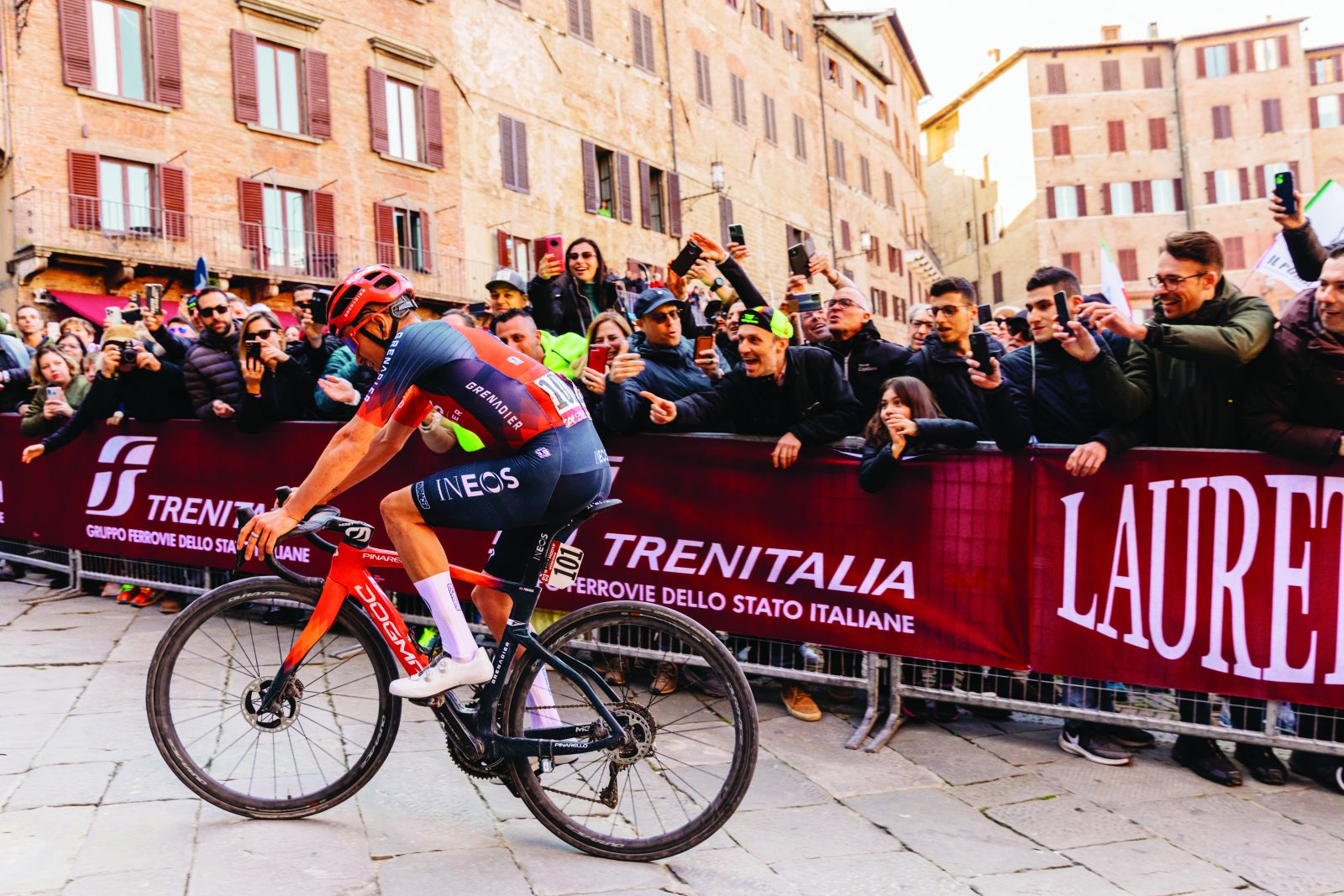
Little wonder the team stops for post-ride selfies in the Piazza del Campo. Guazzini does not take racing in her backyard for granted. The former Team Pursuit World Champion almost quit cycling in 2020, struggling to enjoy it after the Covid lockdown. Two years later, following a crash at the 2022 Paris-Roubaix in which she severely broke her ankle, she thought she’d never walk again. Pro cycling is all about sacrifice; she dreams of winning ‘her race’ but her role is to support the team leader, Cecilie Uttrup Ludwig. The emotions are still overpowering.
‘Last year when I did the final ramp to get to the Campo I heard a lot of people screaming my name and I was in tears,’ Guazzini says. ‘I was going very slow so I could see everyone. Some of them used to be at my local races. It’s nice to see they still follow cycling and support us.’
While the narrow, steep Via Santa Caterina leading up to the square is queenmaker, fighting for position is crucial on the gravel sterrate that test nerves and whittle the bunch down. Those in front can choose their own lines and fates.
‘This race is a bit like the vicissitudes of life,’ says Ulissi. ‘You hope it’ll be plain sailing but there can be punctures, crashes, bad luck. It’s a special metaphor.’
Riders are tense all day, highly attuned to the actions of those around them as well as their own slipping wheels.
Back to the fear. ‘It can work for or against you,’ Ulissi says. ‘In my view, you want that bit of fear to raise your focus level in the bunch.’
In the absence of UAE Team Emirates talisman Tadej Pogačar, Ulissi acknowledges it will be difficult for him to win.
‘However, you never know in bike racing, do you? Sometimes it surprises you.’
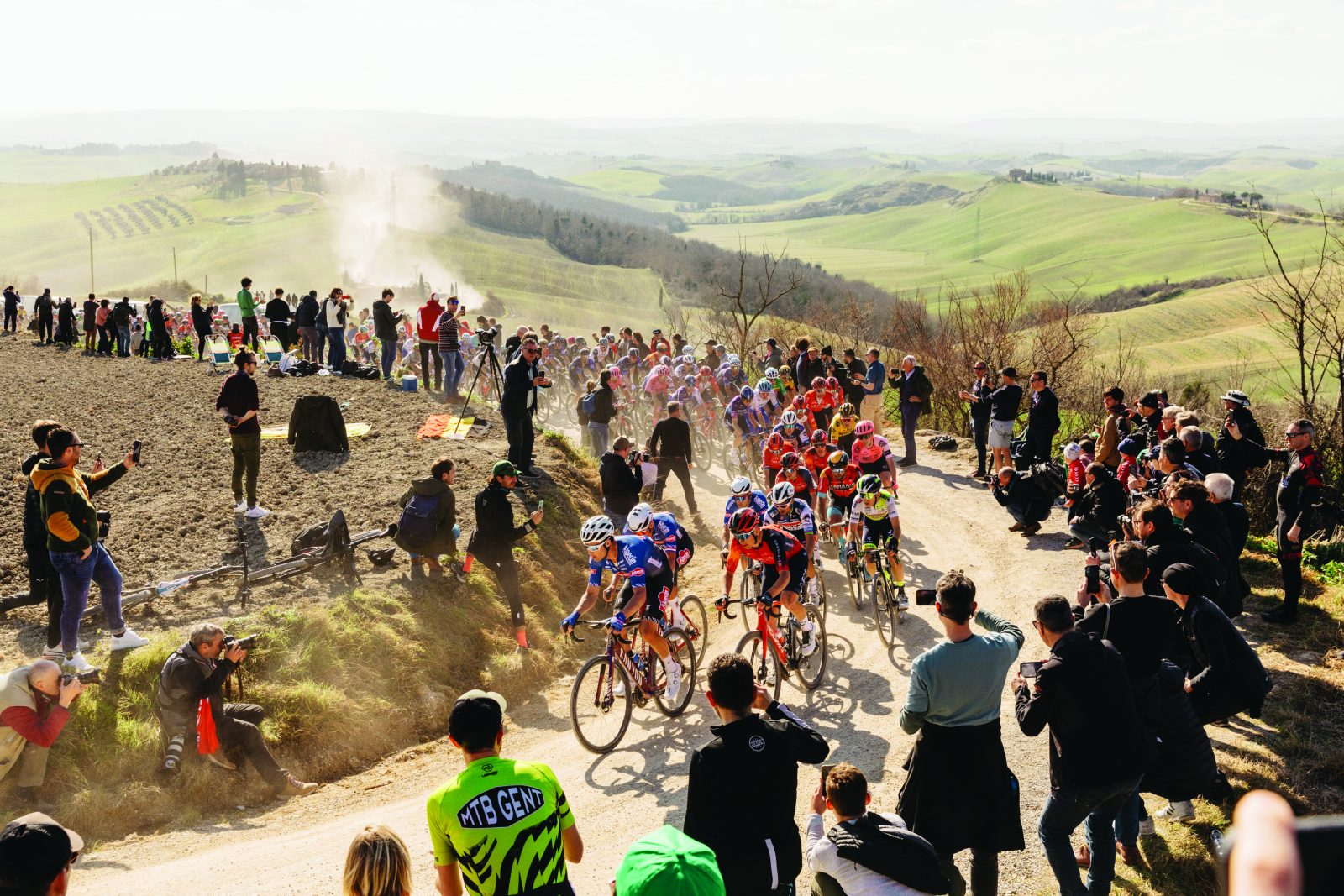
Dust storm
Race day comes with a sky the shade of an Astana Jersey. Cyclist is standing at Sector 7 of San Martino in Grania, and when the riders pass they are a blur of dusty faces and bloodshot eyes. It’s a reminder that Tuscany’s steep climbs decide the race as much as the gravel: there is over 3,100m of elevation on the route for the men, more than 1,900m for the women.
Ulissi’s words ring true as the women’s race unfolds later the same day. Perhaps unaware that the Palio is four months away, a horse briefly breaks free and onto the road, spooking breakaway race leader Demi Vollering.
The men’s and women’s races play out differently. The SD Worx pairing of Vollering and Lotte Kopecky sew up the race on the escape but then duel each other all the way to the line. Tom Pidcock (Ineos Grenadiers) plays the long game and resists the chase for 40km to win. There’s a man who can handle his bike and his fear.
Guazzini crosses the line 61st and collapses into the arms of Cecilie Uttrup Ludwig for a sweaty hug on the Piazza del Campo. She then embraces her proud mother Beatrice at the finish.
After finishing 14th, Ulissi is greeted by his parents and a dozen old friends at his team bus.
‘I saw a lot of people crashing in front of me, around me, near me,’ he says. ‘So to stay upright and give my all, I’ll go home happy.’
The magic of Strade Bianche has sunk in: ‘That last part is super-tough. For five minutes afterwards you can’t compute anything. But once you finish, with the palace in front of you, and pass through Siena’s historic centre, you pause and realise how beautiful this race is.’
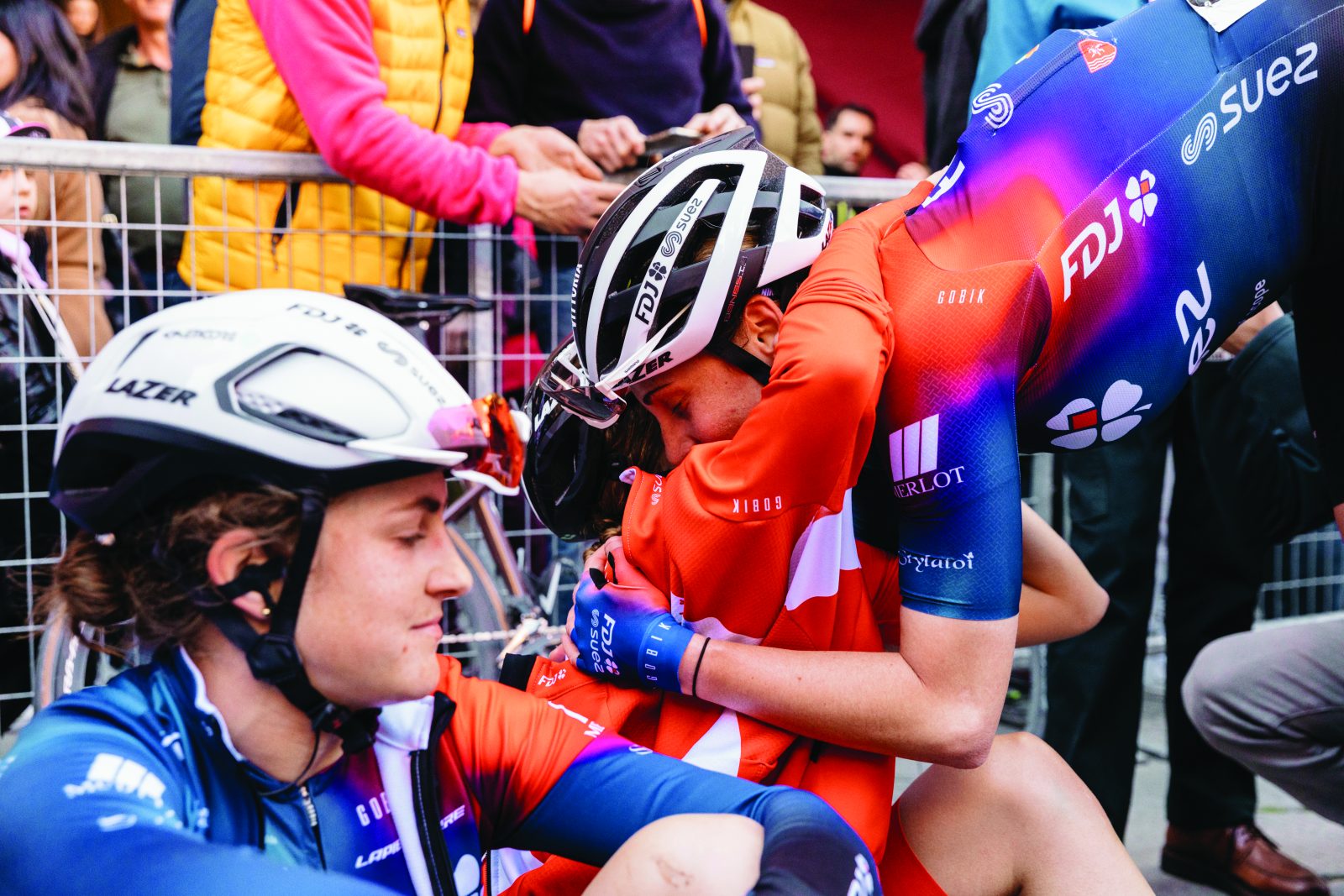
The Palio
This is the place where a horse trots into a church to be blessed. This is the place where a goose defeats a panther while shaking off a giraffe. These aren’t hallucinations from too many hours under the Tuscan sun, just snapshots from the weird, wonderful universe of Siena’s Palio.
The basics are the straightforward part: the Palio is a bareback horse race for three laps of the tuff-covered Piazza del Campo (tuff is a combination of clay and sand). Ten of the city’s 17 districts, or contrade, take part in each of the two annual Palio races, held in July and August. The contrade are represented by flora and fauna – the Goose, the Dragon, the Giraffe, etc – each with their own colourful emblem.
Like winning Strade Bianche, glory at the Palio often requires deep strategy, months of preparation, good fortune, occasional deception and a dedicated backing team. Fear is fatal here too.
While the horse race is done and dusted in 90 seconds, the race itself is only the tip of the iceberg, the headliner of a city-wide festival of life. Unsurprisingly for a race going since 1633, rites rule. The velvet-clad band members who parade pre-race may look like Shrek’s Lord Farquaad, but this is no medieval cosplay. The Palio means the world to the people of Siena, and it is a world unto itself of pageantry and drama.
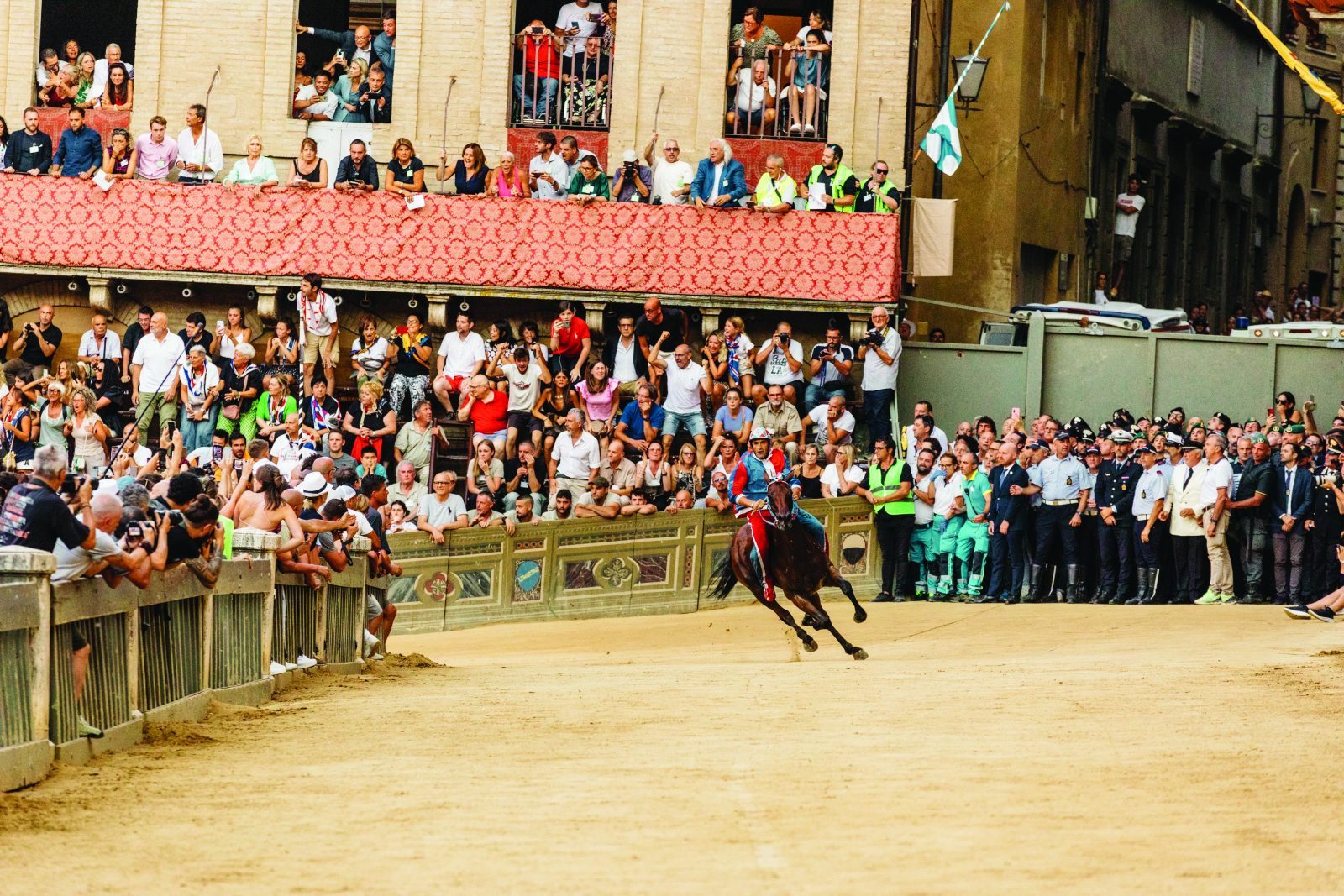
‘The horse is the real hero,’ says Dragon pro-vicario (think logistics chief if it was a cycling team) Giovanni Molteni. They are cared for in stables, hidden away in the old city’s alleyways. They have a unit of carers and farriers at their disposal. For example, Dragon’s veterinarian gets to know the horse’s personality, condition and proclivities. He discovered that their last one liked eating watermelon. How’s that for marginal gains?
Crashes happen every year and horses are occasionally put down, which means the race attracts protests from animal rights groups.
‘A preconception of the Palio is hurting animals,’ Molteni says. ‘However a horse is born to run. If you keep it in its stable and it can’t move, you can give it physical problems. There are always falls. Zero risk doesn’t exist.’
There are three days of preparatory trial races before Palio day, with the packed piazza in full voice. Aside from that, the jockey is guarded day and night to avoid bribery. After all, part of the tactics is brokering secret arrangements. Discussions are led by the captain of each contrada and depend on eventualities such as the horse’s quality and their starting position, as well as the many allies and rivalries between districts. Panther and Eagle despise each other. Goose and Tower have serious beef.
‘It takes too long to explain,’ one contradaiolo (district supporter) sighs when asked. Most of these rivalries go back over 400 years. The money to influence rivals is built up by annual contrada subscriptions and regular dinners over the year.
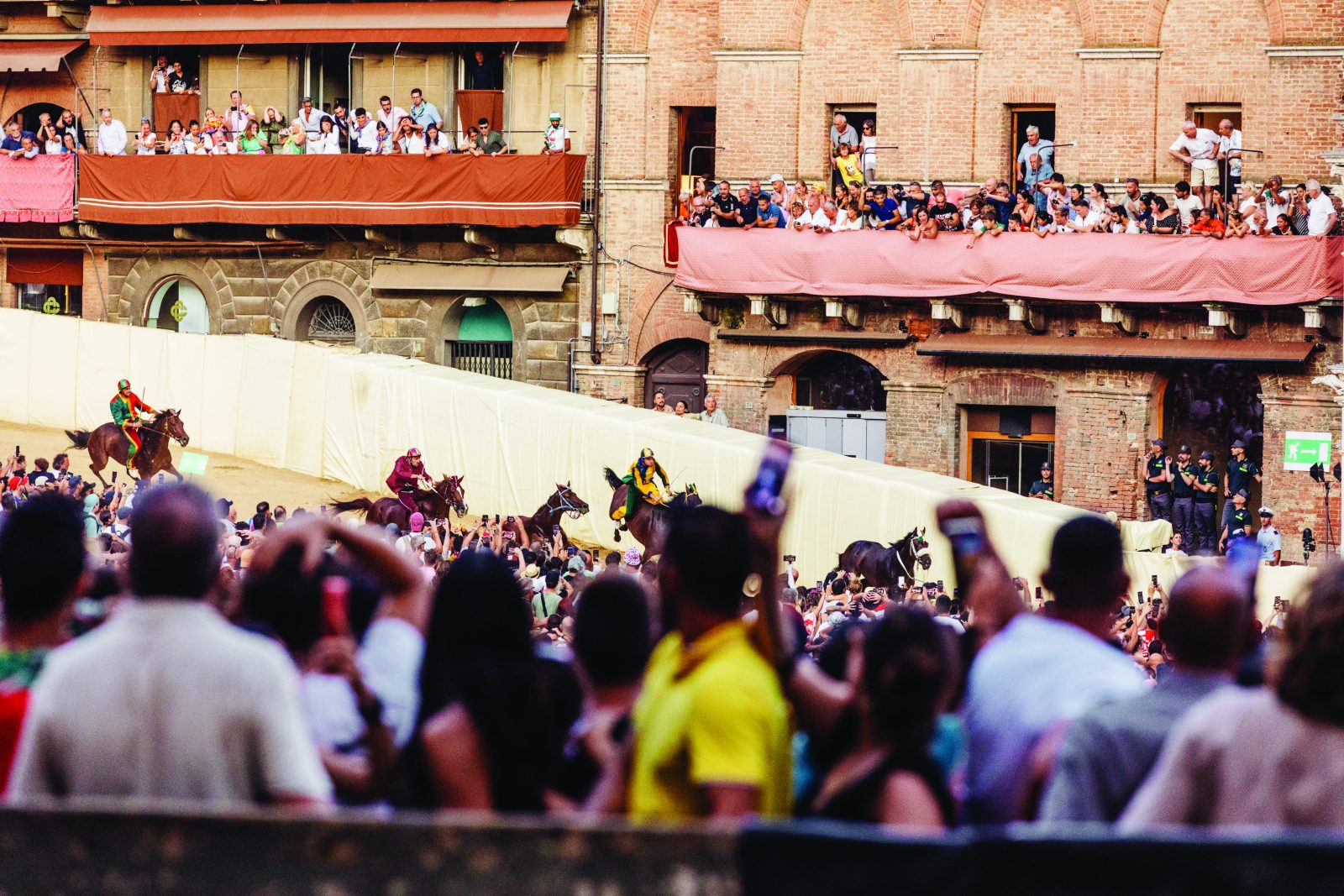
Sound and fury
At the traditional Dragon banquet on the eve of the race, the thousand attendees launch into raucous renditions of their anthem and roar on their jockey. Meanwhile, the younger members serve the food and drink as a rite of passage. Contrada life goes beyond community; it’s a second family. Each member receives a silk neck scarf at birth, which are ubiquitous at the Palio.
‘There’s huge social responsibility here,’ says Dragon veterinarian Piet Ramzan. ‘I think this is the perfect society. It’s got this chess game undercurrent [of the Palio] throughout, which runs all year round.’
The bell in the Piazza del Campo’s tower tolls on 16th August – race day. Both jockeys and horses receive blessings. Each contrada marches to the Piazza del Campo together. Hundreds of men first, women and children second (how medieval), walking metres behind the horse and singing songs of pride and spite.
As the Piazza del Campo’s wooden stands fill, it looks like five football derbies in one stadium. Except this is life and pride on the line.
‘This isn’t sport, it’s love. And you can’t explain love,’ says Roberta Ferri, the Palio’s veteran press officer. The passion of the Sienese people is the Palio’s beating heart.
The crowd cheers the winning horse as it is paraded down the road. A few reach out to touch it, as if putting a hand out to the Pope
‘You go to the Palio with hope,’ says Snail contradaiolo Vittorio Testa, sporting a red and yellow neck scarf and Gucci sunglasses. ‘In 90 seconds the work of a year, sometimes longer, is condensed. And in 90 seconds you can go from happiness to anger to complete apprehension.’
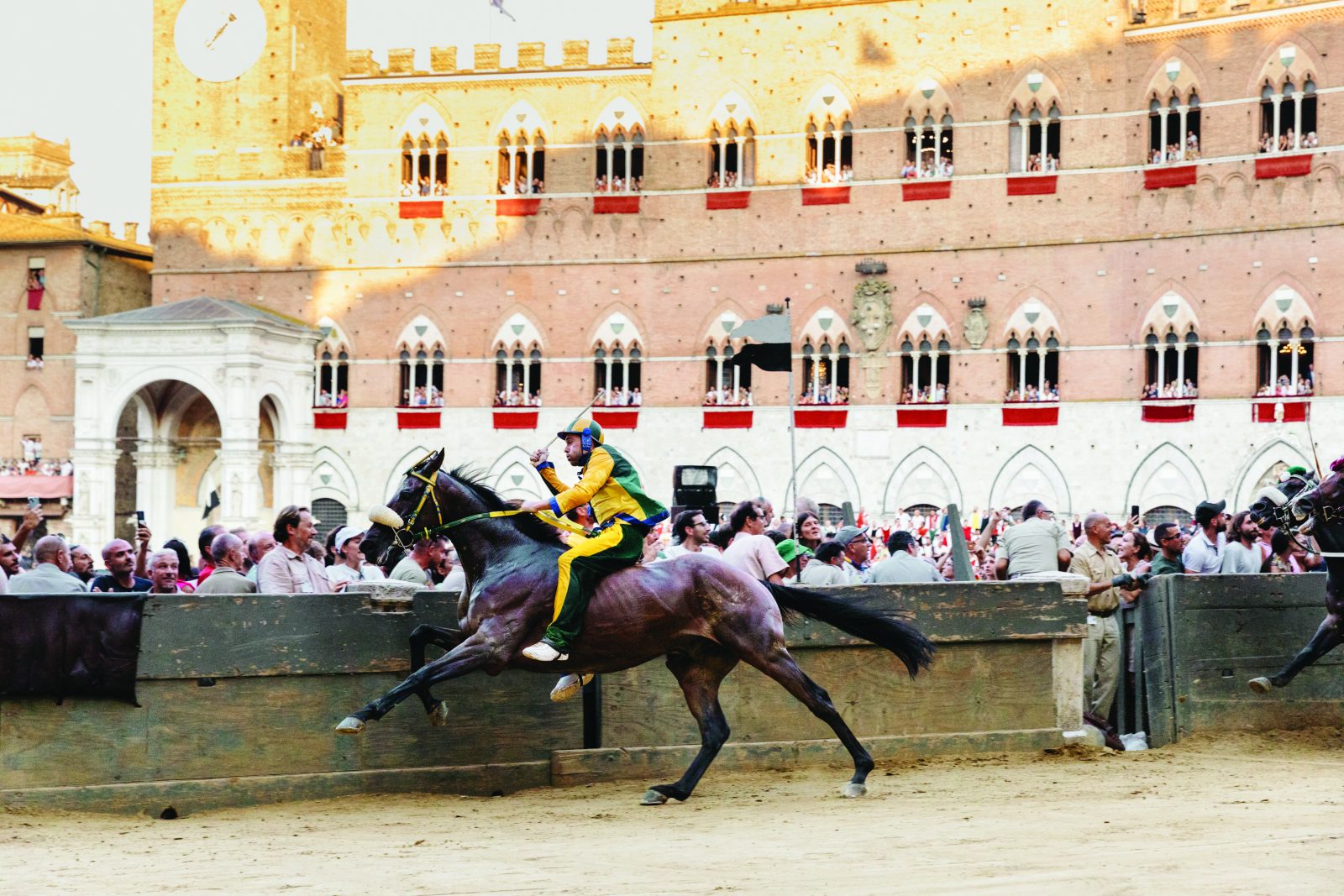
Approximately 15,000 people cram into the middle of the piazza. Entry is free, but it’s an endurance test for them and their sun cream brand. It is an authentic, old-school experience: there are no advertising hoardings, toilets or big screens. The jockeys still wear metal helmets and use whips made from bull penises.
After hours of band processions and rat-a-tat drums, silence falls as the starting order is decided. Lining up, tightly packed horses and jockeys jostle (they’re even allowed to whip each other). Time and time again the race starter has to re-settle them while crowd members hurl obscenities at him. And you thought the Grand National was disorderly.
After 30 minutes of inertia, they’re off, thundering hooves drowned out by the crowd’s roars. Giraffe strides ahead in the opening seconds but crashes at the trickiest bend, San Martino. Panther gallops into the lead, but also falls. Eventually a riderless horse crosses the line first as a cannon booms to signal the finish. Yes, a horse without a jockey can win the Palio, as long as it maintains its plumed headpiece.
To the Goose contrada, the glory. Green-clad men in tights run onto the track, hands in the air in ecstasy. Their prize, the drappellone banner, is passed to their joyous mass. There are no other results here: it’s victory or nothing.
The Piazza del Campo empties and a whole city breathes again. The Goose contradaioli march on the cathedral with their banner, bathed in golden hour sunlight. A delirious mass of singing and hugging locals celebrates their first Palio victory in ten years. Family, community and religion in one, it is total emotional overload.
On Via Santa Caterina – the decisive final climb of Strade Bianche – the crowd cheers the winning horse as it is paraded down the road. A few reach out to touch it, as if reverently putting a hand out to the Pope (the fallen jockey, meanwhile, is in hospital for a broken ankle).
The horse, Zio Frae, even gets his own poster in the local newspaper the next day. Not even Tom Pidcock had that.
While both quintessentially Tuscan, Strade Bianche and the Palio are incomparable in their size and level of emotion provoked. The horse race far outweighs the bike race in terms of global fame thanks to its history, charm and chaotic magic. But it has had a 380-year head start.
